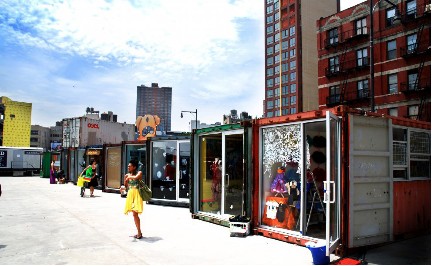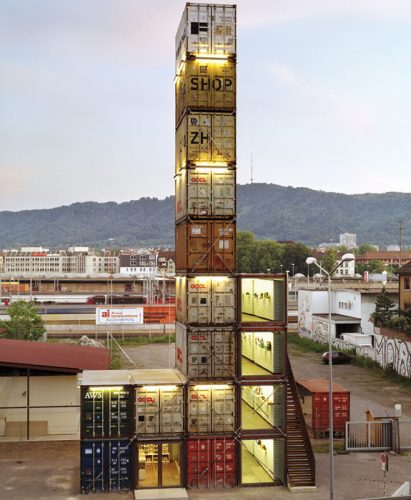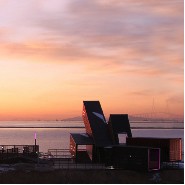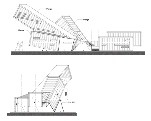Recently a group approached Eco Brooklyn to help build a cool project involving shipping containers. The project is ambitious: three walls of containers arranged around a central triangular courtyard. The
walls are six levels of shipping containers high totaling 84 shipping containers overall. This is a second attempt to get such a project going. Their first attempt – an eight story shipping container on the Upper East Side – fell through.
As a New York green contractor we really like shipping containers as buildings; they appeal to our affinity for creative reuse and modular construction. Thousands and thousands of shipping containers are sitting stagnant in ports all over the world. In the 1970’s “shipping container architecture” began as trend in design and more recently the already existing building material is moving to the forefront of the sustainable architecture movement. Here are a few examples of architecture which ingeniously utilizes these bountiful, colorful, movable boxes.
Typically when we think of a Japanese tea house, we think of low, thatched roof structures, but with Sky is the Limit, Portuguese artist, Didier Faustino decided to perch this space resting high above the rough sea in Yang Yang, South Korea.
He used two shipping contains to provide a sea-facing observation space atop a tower made out of scaffolding. Visitors must first climb five flights of stairs in order to reach the top of the 65-foot scaffolding.
Holiday Cabana at Maduru Oya
 Sri Lankan architect, Damith Premathilake was commissioned to design and build a holiday cabana at Maduru Oya.
Sri Lankan architect, Damith Premathilake was commissioned to design and build a holiday cabana at Maduru Oya.
The lake house sits on an army training camp surrounded by jungles facing a lake as mountains appear in the distance. The structure is made out of materials that were all found on site such as timber from weapons boxes and shipping container.
The project took a total of one month to complete and is total of 700-square feet.
OceanScope
Korean designers, Keehyan Ahn & Minsoo Lee have used shipping containers to design a public observatory called Oceanscope. In order to overcome the restraints of the building site, where the ground level is too low to view the sunset across the harbor, the architects utilized old shipping containers to overcome the limitation.
The shipping containers are angled at 10’, 30’ and 50’ to achieve different views. As depicted in the diagram, the observer enters the shipping container and rests ones back against the angled wall, to view the reflection of the sunset through the mirror on the opposite side.
Shipping containers are used for temporary shelter in many rural areas of Korea because of their low cost.
However, indiscreet uses of this recycled product often don’t create harmonious relationships with the natural context because of their industrial aesthetic. Keehan Ahn & Minsoo Lee have been able to take this construction building block and mold it into an innovative prototype for the future of shipping container construction.
Normad Skyscraper
 Globalization has given people the ability to not just be citizens of one city or region but become citizens of the world. Luca D’Amico and Luca Telso, two Italian architects submitted this “Nomad Skyscraper” design to a Skyscraper competition in 2011.
Globalization has given people the ability to not just be citizens of one city or region but become citizens of the world. Luca D’Amico and Luca Telso, two Italian architects submitted this “Nomad Skyscraper” design to a Skyscraper competition in 2011.
The concept centers on using shipping containers that act as individual, personalized apartment units, which can be plugged into the permanent scaffolding. The main structure would provide basic infrastructure as well as recreational areas.
Units could theoretically be transported by ship, truck and train and transported to other cities, which have this same infrastructure.
Dekalb Market
 These shipping container projects are also happening right here in Brooklyn. Take Dekalb Market for example, this low impact, relatively low cost, shopping center has become a centerpiece for the architecture of New York City.
These shipping container projects are also happening right here in Brooklyn. Take Dekalb Market for example, this low impact, relatively low cost, shopping center has become a centerpiece for the architecture of New York City.
Newark, New Jersey is home to one of the largest ports in North America, there is plethora of these module containers (in a variety of colors!) sitting and waiting to be shipping back to their port of origin. UK developers Urban Splash created a configuration made out of 22 shipping containers occupy a portion of Downtown Brooklyn.
Frietag Flagship Store
 One of our readers spent us a link to another incredible example of innovative shipping container design. The Frietag flagship store is composed entirely of rusty, recycled shipping containers that have been gutted, reinforced and configured to serve Frietag, a Swiss company that specialized in products made from recycled materials.
One of our readers spent us a link to another incredible example of innovative shipping container design. The Frietag flagship store is composed entirely of rusty, recycled shipping containers that have been gutted, reinforced and configured to serve Frietag, a Swiss company that specialized in products made from recycled materials.
Frietag took its initial objective (creating beautiful products from truck tarpaulins) and pushed it a step further by selling its recycled products within a recycled product.
The building is striking upon first glace, the first two floors are composed of four shipping containers (4×2), and the number of shipping container decreases as the height increases.
This structure is the world’s tallest recycled building, but short enough so that it does not infringe upon the coding laws of Zurich.



